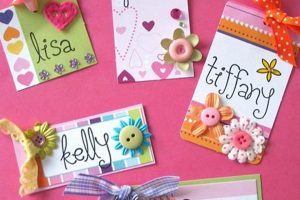The creation of confectionery-based floral arrangements is a craft project involving the assembly of candies into a visually appealing bouquet-like structure. This process often utilizes skewers or floral wire to attach individual sweets to a central base, mimicking the appearance of traditional flower bouquets. For instance, assorted chocolates, lollipops, and hard candies can be arranged to resemble roses, tulips, or other botanical forms.
The appeal of constructing these sweet displays lies in their personalized nature and suitability as gifts for various occasions. These edible presentations offer a unique alternative to conventional floral gifts, providing both aesthetic enjoyment and gustatory pleasure. Historically, the practice of gifting food items as tokens of affection dates back centuries, and the confectionery bouquet represents a modern adaptation of this tradition, combining visual artistry with consumable goods.
Consequently, the ensuing discussion will delve into essential materials, step-by-step assembly techniques, design considerations for achieving visually striking arrangements, and practical tips for maintaining the longevity and structural integrity of these handcrafted edible gifts.
Essential Guidelines for Confectionery Arrangement Creation
The following recommendations aim to enhance the construction and presentation of handcrafted confectionery arrangements, ensuring both aesthetic appeal and structural soundness.
Tip 1: Prioritize Structural Integrity: Select candies that are lightweight and easily secured. Heavy items may compromise the arrangement’s stability, leading to collapse. Use floral foam or a similar dense material as a base to provide a firm anchor for skewers or wires.
Tip 2: Employ Food-Safe Adhesives: If adhesives are necessary for securing candy wrappers or decorative elements, ensure that the chosen adhesive is explicitly designated as food-safe and non-toxic to prevent potential contamination.
Tip 3: Consider Environmental Factors: Be mindful of temperature and humidity levels. Chocolate, in particular, is susceptible to melting or blooming in warm conditions. Store the completed arrangement in a cool, dry environment to preserve its visual appeal and prevent spoilage.
Tip 4: Utilize Color Harmony: Employ color theory principles when selecting candies. A cohesive color palette enhances the overall aesthetic impact. Consider monochromatic, analogous, or complementary color schemes for a visually pleasing result.
Tip 5: Incorporate Non-Edible Elements: Introduce non-edible decorative elements such as ribbons, artificial flowers, or tissue paper to add visual interest and texture. These additions can complement the candies and enhance the bouquet’s overall presentation.
Tip 6: Ensure Secure Attachment: When attaching candies to skewers or wires, take care to avoid puncturing the candy itself. Instead, secure the wrapper or packaging. This minimizes the risk of contamination and prevents the candy from crumbling or falling off.
Tip 7: Protect the Arrangement During Transport: When transporting, enclose the arrangement within a protective container to prevent damage. Bubble wrap or tissue paper can be used to cushion the candy and minimize movement during transit.
Adhering to these guidelines will contribute to the creation of visually appealing, structurally sound, and safe confectionery arrangements that are suitable for gifting or display.
These practical considerations provide a foundation for progressing to the final stages of project completion.
1. Candy Selection
The choice of confectionery is a foundational element in the construction of edible floral arrangements. The selection process directly impacts the bouquet’s aesthetic appeal, structural integrity, and overall suitability for its intended recipient and occasion. Strategic candy selection transcends mere preference; it represents a deliberate design decision.
- Weight and Shape Considerations
The physical properties of individual candies significantly influence the stability of the final arrangement. Lightweight candies, such as lollipops or individually wrapped chocolates, are preferable to heavier items that may cause structural imbalance. Uniform shapes, such as spheres or cylinders, are easier to incorporate into a cohesive design than irregularly shaped candies.
- Color Palette and Visual Harmony
The color spectrum of the chosen candies dictates the visual impact of the bouquet. A carefully curated color palette can evoke specific emotions or complement the occasion for which the arrangement is intended. Monochromatic schemes offer a sophisticated aesthetic, while contrasting colors create a vibrant and playful effect. Color choices also influence perceived value, with richer colors often suggesting a more premium offering.
- Durability and Environmental Stability
Candies susceptible to melting or deformation under varying temperature or humidity conditions are ill-suited for arrangements intended for extended display or outdoor events. Hard candies and individually wrapped confections offer greater resistance to environmental degradation than chocolate-based items. The selection should also consider the recipient’s storage capabilities to ensure longevity and prevent spoilage.
- Allergenic Properties and Dietary Restrictions
In crafting a personalized confectionery arrangement, awareness of potential allergenic ingredients is paramount. Common allergens, such as nuts, dairy, or soy, must be avoided if the recipient has known sensitivities. Likewise, adherence to dietary restrictions, such as veganism or sugar-free diets, necessitates careful selection of appropriate confectionery alternatives.
In summation, astute decision-making regarding confectionery options extends beyond taste preferences. It encompasses strategic planning to produce an aesthetically pleasing, stable, and considerate edible artwork. Each selection should be weighed against factors like structural requirements, visual design principles, environmental effects, and dietary needs, ensuring a delightful and thoughtfully customized final result.
2. Floral Arrangement Techniques
The adaptation of established floral arrangement techniques is critical to the successful execution of confectionery bouquets. While the medium shifts from botanical elements to edible items, the underlying principles of design, structure, and balance remain fundamentally relevant.
- Stemming and Support Adaptation
Traditional floral arrangements rely on stems to provide structural support and facilitate arrangement. In candy bouquets, this translates to the use of skewers, floral wire, or similar implements to secure individual con
fectionery items. The careful placement and angling of these “stems” are vital for creating visual flow and preventing the arrangement from becoming unwieldy or collapsing. For example, heavier candies may require thicker gauge wire or multiple supports to maintain their position within the bouquet. - Focal Point and Visual Hierarchy
Floral design emphasizes the creation of a focal point to draw the viewer’s eye and establish visual hierarchy. This principle applies directly to confectionery arrangements. Larger or more visually striking candies can be strategically placed to serve as the focal point, surrounded by smaller or less conspicuous items to create depth and dimension. Techniques such as clustering candies of similar colors or textures around the focal point can further enhance its prominence.
- Color Harmony and Texture Variation
The principles of color theory are equally applicable to confectionery arrangements. A harmonious color palette enhances the aesthetic appeal, while variations in texture add visual interest. For instance, pairing smooth, shiny chocolates with textured hard candies or incorporating non-edible elements like ribbons or tissue paper can create a dynamic and engaging composition. Consideration should be given to the emotional associations of different colors, selecting hues that align with the intended message or occasion.
- Balance and Proportion
Achieving visual balance is crucial for creating a pleasing and stable arrangement. This involves distributing the weight and visual mass of the candies evenly throughout the bouquet. Asymmetrical balance can be achieved by strategically placing larger or more dominant candies on one side, counterbalanced by a cluster of smaller items on the opposite side. Proper proportion is also essential; the size of the bouquet should be appropriate for its intended purpose and setting. An excessively large arrangement may appear overwhelming, while a diminutive one may lack impact.
The successful application of floral arrangement techniques to the confectionery medium results in an aesthetically pleasing and structurally sound “candy bouquet diy”. A conscious effort in understanding stem adaptation, focal point creation, color harmony, and balance can elevate the final presentation, transforming simple candies into a work of art.
3. Structural Support
The framework underpinning a confectionery arrangement is fundamental to its overall presentation and longevity. Adequately implemented structural support mitigates the risk of collapse, ensuring the aesthetic integrity of the arrangement throughout its display life. This element directly impacts the feasibility and visual appeal of the final product.
- Base Material Selection
The foundation of a confectionery arrangement dictates its stability. Options range from floral foam, providing a dense matrix for skewer insertion, to lightweight alternatives like paper mache cones or pre-formed bouquet holders. The chosen material must possess sufficient rigidity to support the weight of the candies without deformation. Examples include using a heavy-duty floral foam for arrangements with numerous or dense confections versus a lighter foam for smaller, simpler arrangements. Inadequate base selection can lead to tilting or complete structural failure.
- Attachment Mechanisms
The means by which individual candies are affixed to the base are critical. Options include wooden skewers, floral wire, hot glue (used sparingly and indirectly on wrappers), and specialized confectionery sticks. The selection depends on the candy’s size, weight, and the desired aesthetic. For instance, floral wire can be easily shaped to create intricate curves and patterns, while skewers offer a more straightforward and robust attachment point for heavier items. Improper attachment compromises the security of individual candies and the bouquet’s overall structural integrity.
- Weight Distribution Strategies
Effective structural support relies on balanced weight distribution. Heavier candies should be positioned closer to the base to lower the center of gravity, while lighter candies can be placed higher in the arrangement. Strategically spacing heavier elements prevents localized stress on the base and attachment mechanisms. An example of poor weight distribution is clustering all the heavier chocolates on one side, leading to a noticeable lean or even tipping. Proper distribution maintains equilibrium and prevents premature degradation.
- Reinforcement Techniques
For larger or more complex arrangements, reinforcement strategies may be necessary. This can involve using multiple skewers or wires per candy, incorporating a hidden internal support structure (e.g., a dowel rod), or applying a sealant to the base to prevent crumbling. The choice of technique depends on the specific design and the anticipated stresses on the arrangement. Reinforcement is particularly important for arrangements intended for transport or prolonged display. Failure to reinforce adequately can result in a gradual weakening of the structure and eventual collapse.
These facets of structural support are integral to the successful fabrication of confectionery arrangements. By carefully considering base materials, attachment mechanisms, weight distribution, and reinforcement techniques, the structural integrity of the arrangement can be maximized, ensuring its visual appeal and longevity.
4. Aesthetic Design
Aesthetic design plays a pivotal role in the success of any “candy bouquet diy” project. The visual appeal of the arrangement directly influences its perceived value and suitability as a gift or decorative item. Choices concerning color palettes, form, and the arrangement of individual components contribute significantly to the overall aesthetic impact. A poorly designed bouquet, irrespective of the quality of the confectionery, will likely fail to achieve its intended purpose. For example, an arrangement employing clashing colors or a disorganized structure can appear amateurish and unappealing, diminishing its desirability.
The application of design principles, such as balance, proportion, and rhythm, is essential. Balance ensures visual stability, preventing the arrangement from appearing top-heavy or lopsided. Proportion dictates the relative size of elements, maintaining harmony and preventing any single component from overwhelming the others. Rhythm, achieved through the repetition and variation of elements, creates visual interest and guides the viewer’s eye through the arrangement. Consider a bouquet where chocolates are strategically positioned to create a sense of flow and movement, complemented by the placement of lollipops to add bursts of color and visual texture. Such a deliberate design strategy can transform a simple collection of candies into a captivating visual display.
The challenge lies in translating abstract design principles into a tangible confectionery arrangement. Overcoming this requires careful planning, experimentation, and a keen eye for detail. Ultimately, the aesthetic design determines whether the “candy bouquet diy” project transcends mere novelty and achieves a level of artistry and sophistication that warrants appreciation. Understanding and applying design principles elevate the finished product, ensuring it effectivel
y conveys its intended message and delights its recipient.
5. Wrapping and Presentation
The wrapping and presentation phase is integral to the successful culmination of the confectionery arrangement process. It functions as more than mere encasement; it elevates the perceived value and enhances the aesthetic impact, ultimately transforming a collection of candies into a cohesive and desirable gift. The quality of the presentation directly influences the recipient’s initial impression and overall appreciation. For example, a carefully constructed arrangement, regardless of its confectionery content, may be undermined by subpar wrapping materials or haphazard assembly, diminishing its appeal.
Proper wrapping serves multiple purposes: it provides physical protection, safeguards against environmental factors such as humidity and dust, and unifies the diverse elements into a visually appealing whole. Materials such as cellophane, tissue paper, and decorative ribbons are commonly employed to achieve these objectives. Cellophane offers transparency, allowing the arrangement to remain visible while providing a protective barrier. Tissue paper adds textural contrast and can be used to fill gaps or create visual layers. Ribbons contribute a touch of elegance and can be selected to complement the color scheme of the confectionery. A real-world example would be utilizing a clear cellophane wrap secured with a satin ribbon matching the dominant color of the candies, adding a card appropriate to the occasion.
Ultimately, the effectiveness of the wrapping and presentation hinges on attention to detail and a cohesive design strategy. A well-executed presentation enhances the perceived value, protects the arrangement from damage, and conveys a sense of thoughtfulness and care. Neglecting this crucial phase can diminish the impact of even the most skillfully crafted confectionery arrangement. Therefore, the selection of appropriate materials, meticulous assembly, and adherence to design principles are essential components of a successful “candy bouquet diy” endeavor.
6. Preservation Methods
The longevity and aesthetic appeal of a confectionery arrangement are intrinsically linked to the preservation methods employed. The inherent perishability of many candies, particularly chocolates and those with soft fillings, necessitates strategic preservation to mitigate degradation due to environmental factors such as temperature, humidity, and direct sunlight. Without proper preservation techniques, a meticulously crafted arrangement can quickly lose its visual appeal and structural integrity, diminishing its value as a gift or decorative item. For instance, chocolate blooms, a phenomenon where cocoa butter rises to the surface, causing a greyish-white discoloration, are a common consequence of inadequate temperature control. Proper selection and implementation of preservation techniques are, therefore, a crucial component of successful “candy bouquet diy” projects.
Practical application of preservation methods in confectionery arrangements involves several key considerations. Firstly, the selection of candies with inherent resistance to environmental degradation is paramount; hard candies and individually wrapped items generally exhibit superior durability. Secondly, environmental control during both construction and storage is essential; a cool, dry environment minimizes the risk of melting, discoloration, and textural changes. Thirdly, protective wrapping materials, such as cellophane, offer a barrier against humidity and physical damage, extending the arrangement’s lifespan. Lastly, the incorporation of desiccants, such as silica gel packets, within the wrapping can further reduce moisture levels, particularly in humid climates. These proactive measures not only prolong the arrangement’s viability but also maintain its visual appeal, ensuring that the recipient receives a gift that retains its intended charm.
In summary, the application of appropriate preservation methods is not merely an ancillary consideration but an integral aspect of “candy bouquet diy.” Effective preservation techniques, encompassing candy selection, environmental control, protective packaging, and moisture management, directly impact the arrangement’s longevity, visual appeal, and overall value. While challenges such as fluctuating ambient conditions and the perishability of certain candies persist, a thorough understanding and implementation of these preservation strategies are essential for maximizing the lifespan and enjoyment of the handcrafted confectionery gift.
7. Occasion Specificity
The tailoring of confectionery arrangements to particular events or celebrations elevates them beyond generic gifts. Aligning the theme, color palette, and confectionery selection with the specific occasion signifies thoughtfulness and enhances the recipient’s experience, imbuing the arrangement with symbolic meaning.
- Holiday Themes
Confectionery arrangements frequently adopt thematic elements reflective of specific holidays. For instance, Valentine’s Day arrangements often incorporate red and pink candies, heart-shaped chocolates, and romantic motifs. Easter arrangements may feature pastel colors, chocolate eggs, and bunny-shaped candies. This thematic alignment enhances the celebratory spirit and personalizes the gift for the intended occasion. Disregarding the holiday theme diminishes the impact of the arrangement.
- Birthday Personalization
Confectionery arrangements can be personalized to celebrate birthdays by incorporating the recipient’s favorite candies, colors, or hobbies. Including candies that align with the recipient’s preferences demonstrates attentiveness and makes the gift more meaningful. Customization may extend to incorporating age-specific candies or a small, non-edible item that reflects the recipient’s interests, such as a miniature figurine or a small, themed trinket.
- Achievement Celebrations
Arrangements designed to commemorate achievements, such as graduations or professional milestones, often employ colors associated with success and accomplishment, such as gold, silver, or school colors. The confectionery selection may include premium chocolates or candies considered celebratory treats. The arrangement’s structure may also symbolize progress or upward movement, such as a tiered design or a gradual increase in height.
- Sympathy and Support
Confectionery arrangements intended to offer sympathy or support typically adopt a more subdued and comforting aesthetic. Neutral colors, such as white, cream, or soft pastels, are frequently used, and the confectionery selection may emphasize comforting or familiar candies. The overall design prioritizes simplicity and elegance, conveying a message of empathy and support without being overly celebratory or extravagant.
The integration of occasion-specific elements transforms a generic confectionary display into a personalized and thoughtful gesture. It reinforces the arrangement’s relevance and enhances its impact, demonstrating a clear connection between the gift and the event it commemorates. The conscientious application of these
principles elevates the “candy bouquet diy” from a mere craft project to a meaningful expression of sentiment.
Frequently Asked Questions
The following addresses prevalent inquiries regarding the creation of confectionery-based floral arrangements. The objective is to clarify common uncertainties and provide concise, informative answers.
Question 1: What confectionery types exhibit the greatest suitability for integration into these arrangements?
Hard candies and individually wrapped chocolates are generally recommended due to their structural integrity and resistance to environmental factors. Candies with liquid fillings or those prone to melting should be avoided.
Question 2: What adhesive materials are deemed safe for securing confectionery wrappers without compromising edibility?
Adhesives specifically designated as food-safe and non-toxic are permissible for affixing wrappers or decorative elements. Direct contact between adhesive and edible portions is strictly prohibited.
Question 3: How should a completed confectionery arrangement be stored to prevent degradation?
Storage in a cool, dry environment, away from direct sunlight and fluctuating temperatures, is crucial for preserving the arrangement’s visual appeal and structural integrity. Refrigeration is generally not recommended due to potential condensation issues.
Question 4: What methods are most effective for securing confectionery items to skewers or floral wire?
Confectionery items should be secured by adhering the wrapper to the skewer or wire, avoiding direct puncture of the candy itself. This minimizes contamination risk and prevents structural damage to the confection.
Question 5: How can the structural stability of a confectionery arrangement be maximized?
A dense base material, such as floral foam, provides a stable anchor for skewers or wires. Strategic weight distribution, with heavier candies positioned closer to the base, further enhances stability.
Question 6: What measures can be taken to protect a confectionery arrangement during transportation?
Enclosing the arrangement within a protective container lined with cushioning materials, such as bubble wrap or tissue paper, minimizes the risk of damage during transit. Securely fastening the arrangement within the container is also recommended.
These responses offer a comprehensive overview of essential considerations for crafting and maintaining confectionery arrangements. Adherence to these guidelines contributes to the creation of aesthetically pleasing and structurally sound edible displays.
The subsequent discussion will transition to relevant source citation and reference materials.
Conclusion
The preceding exploration of “candy bouquet diy” has illuminated critical aspects of its creation, encompassing design principles, structural considerations, preservation techniques, and occasion-specific adaptations. This compilation of information serves as a detailed guide for individuals seeking to craft personalized edible arrangements, emphasizing the importance of thoughtful candy selection, secure structural support, and careful aesthetic execution.
Ultimately, successful engagement in “candy bouquet diy” requires a blend of creativity and technical skill. By incorporating the insights presented, practitioners can elevate their efforts from simple assembly to the creation of unique, meaningful, and enduring gifts. The artistry of transforming ordinary confectionery into extraordinary presentations resides in the diligent application of these principles, fostering a future where handcrafted confectionery arrangements achieve heightened levels of artistry and appeal.







